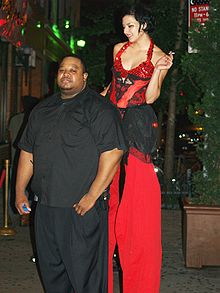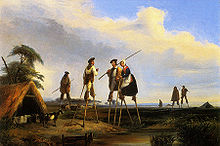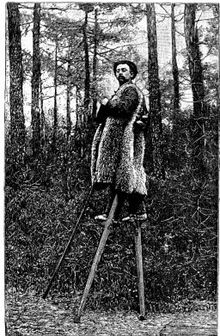- Stilts
-
This article is about the poles. For the type of bird, see stilt. For other uses, see Stilts (disambiguation).
Stilts are poles, posts or pillars used to allow a person or structure to stand at a distance above the ground. Walking stilts are poles equipped with steps for the feet to stand on, or straps to attach them to the legs, for the purpose of walking while elevated above a normal height. In flood plains, and on beaches or unstable ground, buildings are often constructed on stilts to protect them from damage by water, waves or shifting soil or sand. Stilts have been used for many hundreds of years.[1]
Contents
Types of stilts
Hand-held stilts
Hand-held stilts are common childhood toys that typically come in two varieties: string and pole. Unlike other forms of stilts, hand-held stilts are not tied or strapped to the wearer.
Hand-held pole stilts consist of two long poles, each with a foot support. The stilter holds on to the upper end of the pole and rests his feet on the foot plates.
Hand-held string stilts (also known as tin can stilts) are platforms with strings attached to them. The platforms, most commonly made of tin cans, hold the stilter's weight while the strings are used to pull the cans to the feet as the stilter takes a step.
Peg stilts
Peg stilts, also known as Chinese stilts, are the most common stilts used by professional performers. These stilts strap on at the foot, ankle, and knee and give the walker great versatility. These lightweight stilts allow one to walk quickly, to turn suddenly, and even to jump rope or dance. The walker must keep moving at all times to keep himself from falling over.
Drywall stilts
Drywall stilts allow the possibility of standing still or walking. They take their name from their use in drywall construction, but they are also used by painters, actors, and magicians. Drywall stilts are heavier than peg stilts and made for slower but safer walking and working. They are the safest of all stilts.
Spring stilts
Spring stilts are spring-loaded stilts that allow the user to run, jump and perform various acrobatics. Spring stilts using fiberglass leaf springs were introduced in 2004 under the trademark "Poweriser", marketed for recreational and extreme sports use. Using these stilts is also called Powerbocking. Spring stilts using steel coil springs, an antecedent of the pogo stick, were attempted in the 19th century.[2][3]
History of stiltwalking
8 December 1411 : Date of Namur (Belgium) town ordinance dealing with "Echasseur" or "jousting while wearing stilts"! Opposing teams of jousters, the Mélans and the Avresses, battle each other in a wild melee of blows using shoulders and elbows; shoving, jabbing, blocking and tripping their opponents. This jousters still exists today (Echasseurs Namurois). They celebrate in 2011 their 600th anniversary.
This whole of this section except the last line is a copy of an article that appeared in the Scientific American Supplement, No. 821, Sep. 26, 1891 reproduced on the gutenberg.org website here. All of the copied text appears in blockquote.
Sylvain Dornon, the stilt walker of Landes, started from Paris on the 12th of March 1891 for Moscow, which he reached after a journey of fifty-eight days. Although this long journey upon stilts constituted a genuine curiosity, not only to the Russians, to whom this sort of locomotion was unknown, but also to many Frenchmen, walking on stilts, was, in fact, common before the 1870s in certain parts of France.
In the wastes of Gascony stilt walking was formerly a means of locomotion adapted to the nature of the country. The waste lands were then great level plains covered with stunted bushes and dry heath. Moreover, on account of the permeability of the subsoil, all the declivities were transformed into marshes after the slightest fall of rain.
There were no roads of any kind, and the population, relying upon sheep raising for a living, was much scattered. It was evidently in order to be able to move around under these very peculiar conditions that the shepherds devised and adopted stilts. The stilts of Landes are called, in the language of the country, tchangues, which signifies "big legs," and those who use them are called tchanguès. The stilts are pieces of wood about five feet in length, provided with a shoulder and strap to support the foot. The upper part of the wood is flattened and rests against the leg, where it is held by a strong strap. The lower part, that which rests upon the earth, is enlarged and is sometimes strengthened with a sheep's bone. The Landese shepherd is provided with a staff which he uses for numerous purposes, such as a point of support for getting on to the stilts and as a crook for directing his flocks. Again, being provided with a board, the staff constitutes a comfortable seat adapted to the height of the stilts. Resting in this manner, the shepherd seems to be upon a gigantic tripod. When he stops he knits or he spins with the distaff thrust in his girdle. His usual costume consists of a sort of jacket without sleeves, made of sheep skin, of canvas gaiters, and of a drugget cloak. His head gear consists of a beret or a large hat. This accouterment was formerly completed by a gun to defend the flock against wolves, and a stove for preparing meals.
Mounted on their stilts, the shepherds of Landes drove their flocks across the wastes, going through bushes, brush and pools of water, and traversing marshes with safety, without having to seek roads or beaten footpaths. Moreover, this elevation permits them to easily watch their sheep, which are often scattered over a wide surface. In the morning the shepherd, in order to get on his stilts, mounted by a ladder or seated himself upon the sill of a window, or else climbed upon the mantel of a large chimney. Even in a flat country, being seated upon the ground, and having fixed his stilts, he easily rose with the aid of his staff.
One may judge by what results from the fall of a pedestrian what danger may result from a fall from a pair of stilts. But the shepherds of Landes, accustomed from their childhood to this sort of exercise, acquire an extraordinary freedom and skill therein. The tchanguè knows very well how to preserve his equilibrium; he walks with great strides, stands upright, runs with agility, or executes a few feats of true acrobatism, such as picking up a pebble from the ground, plucking a flower, simulating a fall and quickly rising, running on one foot, etc.
The speed that the stilt walkers attained is easily explained. Although the angle of the legs at every step is less than that of ordinary walking with the feet on the ground, the sides prolonged by the stilts are five or six feet apart at the base. It will be seen that with steps of such a length, distances must be rapidly covered.
When, in 1808, the Empress Josephine went to Bayonne to rejoin Napoleon I, who resided there by reason of the affairs of Spain, the municipality sent an escort of young Landese stilt walkers to meet her. On the return, these followed the carriages with the greatest facility, although the horses went at a full trot.
During the stay of the empress, the shepherds, mounted upon their stilts, much amused the ladies of the court, who took delight in making them race, or in throwing money upon the ground and seeing several of them go for it at once, the result being a scramble and a skillful and cunning onset, often accompanied by falls.
In the 19th century, few celebrations occurred in the villages of Gascony that were not accompanied by stilt races. The prizes usually consisted of a gun, a sheep, a cock, etc. The young people vied with each other in speed and agility, and plucky young girls often took part in the contests.
Formerly, on the market days at Bayonne and Bordeaux, long files of peasants were seen coming in on stilts, and, although they were loaded with bags and baskets, they came from the villages situated at 10, 15, or 20 leagues distance.
Today, stilt walking tends to be undertaken often but not solely as an entertainment for children.
Stilt walking records
- Most people to simultaneously walk on stilts: 625. In 2008, Doug Hunt and the North Park Collegiate HS students organized a mass stilt walk of 625 people walking 100 metres (330 ft) on 12-inch peg stilts.[4]
- Tallest stilts walked on: 56.5 feet (17.2 m). Roy Maloy of Australia, while wearing an overhead safety wire, took five independent steps on 56.5-foot stilts weighing 50.6 pounds (23.0 kg) each.[5]
- Heaviest stilts walked on: On 23 December 2010 Roy Maloy broke the world record for walking on the heaviest stilts ever walked on. The stilts were made from red gum telephone pole segments and Roy walked the necessary 40 paces with each stilt weighing 35 kg per stilt.[6]
- Longest stilt walk: 24 hours, 76.17 miles (122.58 km). Zdenek Jiruše of Czechoslovakia covered a distance of 76.17 miles (122.58 km) on stilts within 24 hours on 12 June 1992 in Pelhřimov.[7]
Work and daily life
The inhabitants of marshy or flooded areas sometimes use stilts for practical purposes, such as working in swamps or fording swollen rivers. The shepherds of the Landes region of southern France used to watch their flocks while standing on stilts to extend their field of vision, while townspeople often used them to traverse the soggy ground in their everyday activities.
Aluminium stilts are commonly used by fruit farmers in California to prune and harvest their peach, plum, and apricot trees. Stilts have been used for the washing of large windows, the repairing of thatched roofs, and the installation or painting of high ceilings.
As an employable skill, stilts are most commonly used for drywall construction, finish painting, and hanging suspended ceiling tile.
The local festivals of Anguiano (La Rioja, Spain) feature a dance on stilts in which dancers go down a stepped street while turning. Other stilts walking and dancing festivals are held in Deventer, Netherlands in early July each year, and in Namur, Belgium.
See also
References
- ^ *Les Echasseurs Namurois. (visited 2008-03-11)
- ^ http://www.google.com/patents?id=c6pAAAAAEBAJ&pg=PP1&dq=spring+stilts
- ^ http://www.google.com/patents?id=QmNkAAAAEBAJ&pg=PP1&dq=jumping+stilts
- ^ Record Holders Republic - Doug Hunt
- ^ Australian stilt-walker totters to tallest mark". Brisbane Times. November 3, 2008.
- ^ Brisbane Times. Dec 23, 2011
- ^ Record Holders Republic - Zdenek Jiruse
External links
Categories:- Circus skills
- Footwear
- Walking
- Physical activity and dexterity toys
- Traditional toys
Wikimedia Foundation. 2010.








